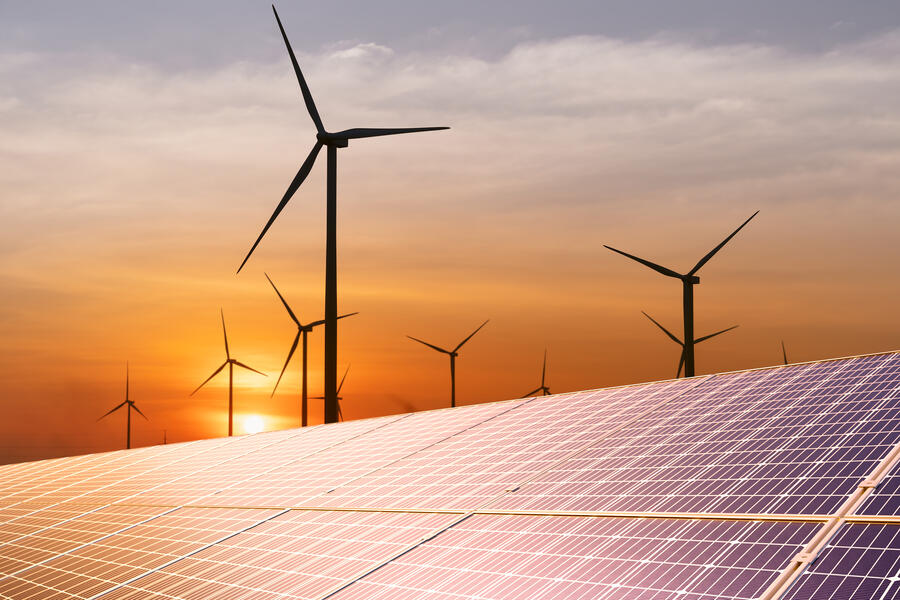- Name
- Doug Donovan
- dougdonovan@jhu.edu
- Office phone
- 443-997-9909
- Cell phone
- 443-462-2947
Under current supply chain conditions, the United States is on track to fall significantly short of surging demand for three clean energy sources—wind, solar, and battery—due to the scarcity of critical raw materials, according to a new study from Johns Hopkins University.
This drastic shortfall could potentially be exacerbated by escalating trade wars and tariffs, and compounded by the surging demand for energy being fueled by the exponential growth of artificial intelligence. Unmet surges in energy use have the potential to cause widespread power outages, equipment damage, and increases in electricity rates.
In a new study published in npj Clean Energy, Johns Hopkins University researchers offer insight on the critical dependencies and challenges inherent in U.S. energy supply chains, and suggest how policymakers, industry leaders, and researchers can approach energy production to meet growing demand.
Key Takeaways
- Under current supply chain conditions, the United States is on track to fall significantly short of surging demand for three clean energy sources: wind, solar, and battery.
- The shortage is due to the scarcity of critical raw materials such as nickel, aluminum, and silicon.
- To address the issue, the researchers point to potential policy solutions and technological innovation to find alternatives to scarce materials
The report is a collaborative effort by the Johns Hopkins Ralph O'Connor Sustainable Energy Institute, the NSF Global Center EPICS, Net Zero Policy Lab, the Johns Hopkins Applied Physics Laboratory, and the Johns Hopkins University Department of Political Science. The study finds that limited access to critical minerals and components threatens to stall the clean energy transition just as data centers fueled by AI push power demand to unprecedented levels, raising urgent concerns about climate targets and energy security.
"Even before the recent AI push, the U.S. was facing a rapidly growing demand for energy—particularly electricity—driven by an increase in electric vehicle and transportation systems, buildings, and data centers," said lead author Yury Dvorkin, an associate professor of civil and systems engineering. "Our research highlights a pressing issue: While energy demand driven by AI growth and electrification is soaring, there's a stark gap between this demand and our supply capabilities."
The researchers developed an optimization model to simulate supply chain conditions through 2050. Their analysis focuses on essential raw materials for wind, solar, and lithium-ion battery technologies, identifying bottlenecks that obstruct the nation from meeting its energy needs. The team's findings indicate that under current conditions, the country is on track to achieve just 65% of its energy goals, with several raw materials like nickel, aluminum, and silicon identified as fundamental to meeting energy demand.
The team's optimization model includes the ability to forecast material prices, estimate manufacturing capacities, and simulate geopolitical trade scenarios.
"All of these variables like pricing, regulatory constraints, material availability from either stable partners or autocratic regimes, and permitting timelines have the potential to prevent the U.S. from meeting escalating energy demands," Dvorkin said. "Even when analyzing scenarios with unlimited raw materials, we found that other supply chain constraints would still prevent the country from fully meeting anticipated consumer demand."
Despite the challenges, the researchers identified several options that could help close the gap between energy production and demand.
The team proposes enhancing domestic production and recycling capabilities for critical materials. This approach includes developing new mining projects, advancing recycling technologies, and establishing strong supply chains for secondary materials.
They suggest that policymakers consider supporting domestic material production through incentives like subsidies, tax breaks, and streamlined regulatory processes to reduce American dependence on imports.
The researchers also recommend promoting technological innovation to find alternatives for scarce materials, which could be realized through a combination of government funding and public-private partnerships as well as strengthening international collaboration to ensure a steady supply of critical materials. Strategic partnerships and trade agreements with stable and unstable trading partners could help secure more long-term access to essential resources.
"The primary takeaway is that developing adaptive supply chain strategies is fundamental for the U.S. to be able to weather supply chain disruptions," Dvorkin said.
"Diversifying supply sources, creating strategic material reserves, and implementing risk management strategies all offer benefits to help the country mitigate supply chain shocks and continue providing uninterrupted energy supply for consumers nationwide," he added.
In the near future, Dvorkin's team intends to build upon this work by exploring scenarios in which supply chains and grid capacities can be dynamically adjusted to maximize resource availability. The team's ultimate goal is to create resilient, adaptable energy systems that can withstand supply chain fluctuations and evolve alongside growing energy demands.
Posted in Science+Technology
Tagged energy, civil engineering, ralph s. o'connor sustainable energy institute








